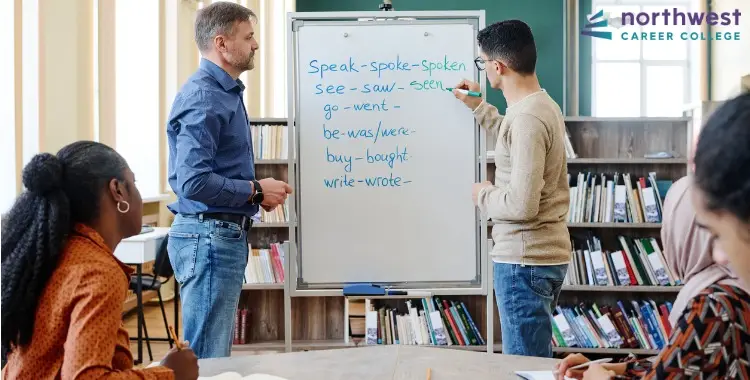Different Language Teaching Methods
- ESL Courses
- February 25, 2025
- 17.9k views
- 4 min read

While most of us are familiar with the language teaching methods used in secondary education, there is a huge variety of language learning methods available. Some of them are better suited to certain learners than others.
To help, we’ve put together a list and a brief description of different language learning methods that might work for you.
Read More: What Are the Oldest Languages in the World?
Table of Contents
Different Language Teaching Methods
The Direct Method
In this method, the teaching is done entirely in the language being learned. The learner is not allowed to use his or her original language. Grammar rules are avoided and there is an emphasis on good pronunciation.
Grammar-Translation
In this method, learning is largely by translation to and from the target language. Grammar rules are to be memorized and long lists of vocabulary learned by heart. There is little or no emphasis placed on developing oral ability. This method is most commonly used in secondary education.
Audio-Lingual
The theory behind this method is that learning a language means acquiring habits. There is much practice of dialogues in every situation. New language is first heard and extensively drilled before being seen in its written form.
The Structural Approach
This method sees language as a complex of grammatical rules which are to be learned one at a time in a set order. So for example the verb “to be” is introduced and practiced before the present continuous tense which uses “to be” as an auxiliary. This method of learning is common in language learning apps.
Total Physical Response (TPR)
TPR works by having the learner respond to simple commands such as “Stand up”, “Close your book”, “Go to the window and open it.” The method stresses the importance of aural comprehension and the importance of kinesthetic learning.
Communicative Language Teaching (CLT)
This method’s focus is on enabling the learner to communicate effectively and appropriately in the various situations she is likely to find herself in. The content of CLT courses includes functions such as inviting, suggesting, and complaining, as well as notions such as the expression of time, quantity, and location. Much like The Structural Approach, this method is commonly used in language learning apps.
Task-based language learning
The teaching focuses on completing a task, which in itself is interesting to the learners. Learners use the language they already have to complete the task, and there is little correction of errors. The aim here is to highlight the importance of learning the language by making it vital to task completion.

The Natural Approach
This approach, propounded by Professor S. Krashen, stresses the similarities between learning the first and second languages. There is no correction of mistakes. Learning takes place by the students being exposed to language that is comprehensible or made comprehensible to them.
Experienced, Efficient And Free For Students
The benefits of taking an ESL course are clear. By improving your English skills you gain better access to education, a better earning potential, a better social life, and even better results from healthcare. At our trade school, we are committed to enhancing our student’s lives, which is why we are proud to offer our ESL courses free of charge to our students and to extend that offer to their families.
Our seasoned language teachers have experience working with international students from all over the world and are there to help you get the most from your classes. To help your lessons fit in with your work and home life, we also offer day and weekend classes. If you are interested in taking advantage of this excellent opportunity, then call one of our ESL counselors today at (702) 403-1592.



